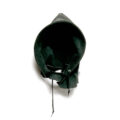Disruption and Openings: Ian Ganassi’s Mean Numbers

Before I knew him as a poet, I knew Ian Ganassi as the percussionist who accompanied my parents’ dance classes: the sound of Ian’s drumming is inextricable from the sound of my mother’s voice counting beats for a room of young dancers. I can hear the sudden silencing of Ian’s drum at the end of a warm-up exercise—fingertips stilled, his palms resting on the head of the drum, the punchy rhythm halted. Vibrations of music play out through the studio and settle with the breath of the dancers.
Since then, Ian’s brief “if you’re interested” emails alerted me, periodically, to his work as a poet and artist, including a decade-long collaboration with the painter Laura Bell on a collage series titled The Corpses (developed through a mail exchange where each artist adds or alters the piece before mailing it back to the other) and translations of Virgil’s The Aeneid (the first seven books were published in the New England Review). Most recently, China Grove Press published his first book of lyric poems, Mean Numbers.
Employing collage (in a purely text-based manner) as a compositional technique—lifted and cobbled from webpage headlines, classical philosophy, and other cultural sound bytes—the poems take on an aphoristic form, often characterized by middleweight absurdism and an estranged consciousness. Take, for example, the beginning of the poem “Semaphore,” from the mid-point of the collection:
The diatribe felt like walking into the middle of someone’s phone conversation.
No one was hired, but no one lost their job.
Turn off the TV, it’s too hot in here.
Beneath it all I just wanted to be left to my own devices.
The pithy economic observation of the third line and absurd logic of “[t]urn off the TV, it’s too hot in here” smother the personal plea in the fifth line: “…I just wanted to be left to my own devices.” Worries about jobs and invasive technology lurk above the desire to be left alone, but Ganassi tempers this sentiment with a play on “devices.” One might think: to be left alone to do what? Write poems? Meditate? Crank the AC and watch YouTube?
The resonance of the work often begins at an end stop—the breath before the brisk change of direction in the next line. Like the moment just after the stilled drumbeat, the transitory space is charged and vacant, inviting and ominous. Listen for the effect in these lines from “The Case on its Merits”:
Millstein and Quagmire promised six figures.
I have a library in my head but I’ve forgotten the Dewey decimal system.
I watched the pot and it boiled.
Lord Flutecracker prepared the punch while his eligible daughter used
Used the chamber pot.I’m embarrassed to be so embarrassed to be so embarrassed to be so
Four and a half Stamford dentists advertise charity whitening on area
Bus shelters.Matilda Catslinger was a munificent contralto.
“How do you feel about your smile?”
Ganassi, unconcerned with a centralized idea, uses rhyme and repetition like guide wire between subjects. I’m reminded of the sound of Lyn Hejinian’s work, where transitions between sentences offer openings for the reader to participate with the poem in an unexpected way. Here’s a short passage from Hejinian’s The Book of a Thousand Eyes. Note briefly the way assonance lends some architecture to the first three lines, similar to Ganassi’s sonic repetition of “I’m embarrassed to be so…”
We three are a trio in a tree
Where like airy riveters we are involuntary saints and all aghast
But maybe it’s more punk than hip-hop to the cops
And when I want to say more, your tongue is in my mouthLike news the day after an election the phalanx of Lipizzaners sidles past
Our praise and blame is left to alternate with praise in endless
controversy
So let’s go slumming on Park Avenue
And let’s make faces when a member of the upper class goes by
While line breaks tend to punctuate the transitions, there is, in the half-breath, a sense of displacement and disruption in Hejinian’s work. It’s an opening of space: an invitation to dream and contemplate, wander and cause some trouble.
Ganassi hopes that his poems “change people’s experience of reality, to help free them.” It’s this intent, combined with the collaged accumulation of text in Ganassi’s work, that brings to mind John Cage. Sometimes mislabeled a “trickster,” Cage’s hyper-composed lectures were often designed to achieve a Zen-like emptiness. In his lecture “Communication,” a list of questions can be read with the cadence of a poem, and in the silence between questions there is the opportunity for reflection and the emptying of the mind.
People aren’t sounds are they?
Is there such a thing as silence?
Even if I get away from people, do I still have to listen to something?
Say I’m off in the woods, do I have to listen to a stream babbling?
Is there always something to hear, never any peace and quiet?
And the list goes on moving from the obvious concerns about sound and silence to the act of asking questions:
Are we getting anywhere asking questions?
Where are we going?
Is this the twenty-eighth question?
Are there any important questions?
“How do you need to cautiously proceed in dualistic terms?”
Do I have two more questions?
And, now, do I have none?
Like Cage, Ganassi trusts the absurd. It’s part a reflection of the world and part a mechanism for loosening the grip of the everyday. Ganassi often pushes already vacant idioms to new and absurd extremes. In “The Prophetic Laundry List” he writes, “[t]he bend in the road could only / [t]ake so much speed before it broke.” While the literal significance of such a line is questionable, it works to create an opening. To assume that these are the whims of a playful linguist, a “trickster”—as one early review of Mean Numbers in the Washington Independent Review of Books suggested—is to oversimplify Ganassi’s poetics. It risks glossing the act of disruption in order to alleviate the challenge of its results.
As playful as the (often humorous) language may be in Mean Numbers, the challenge is generally how to react to confoundment. Is the work in search of laughter or interpretation?
Ganassi’s poems actively challenge the reader to be present, to engage the uneasy openness at the end of a line. Occasionally, this disruption strikes the wrong note. Lines that riff off the quotidian can register a feeling of simple apathy rather than a productive silence. Note these two lines from “A Step at a Time”:
The time is right but this is the wrong bus stop.
Either way it says the same thing either way.
The first line juxtaposes the idea of time with the locality of the bus stop, suggesting the meaninglessness of daily routines. The bus stop may be either wrong or right, but such a description, like the place itself, is insignificant. The second line takes this suggestion to the extreme. The reflection and repetition of “either way” negates its meaning and creates a circular form out of the line, which, when it ends, becomes a voided space.
But, is this emptying also freeing? The apathetic tone makes this feel less like meditation and more like privileged escapism, or maybe, just a complaint.
There are other instances in Mean Numbers when this haranguing of the everyday has an unexpected prophetic weight. In the poem “To Tell the Truth” Ganassi writes:
You can only go so far on anybody’s guess.
Your guess and mine are as good as it gets.
The dark corners that want to take over the world
Are lurking where we put them.
When a guess is “as good as it gets,” fake news stories and malignant tweets invade our feeds and media streams, “lurking where we put them.” Facts fail to shape public opinion. In this sense, Ganassi intuited the new “post-truth” culture, and through this frame, his poems are sobering in their display of the malleability of words and the elusiveness of meaning.
These dark, inadequate, fact-free corners echo the epigraph to Mean Numbers, from Mikhail Bakhtin: “[a]ll language is conventional, false, maliciously inadequate to reality.” But, in the space between lines, during the quiet inhale and exhale of a breath, exists the possibility of a new reality. Ian Ganassi’s acts of disruption allow for clearer truths.
About Lewis Feuer
Lewis Feuer is a poet and visual artist. His recent work has been published by Harvard’s Woodberry Poetry Room and No Infinite: a Journal of Poetry, Art, and Protest. He lives in Brooklyn, NY.





